One man’s trash from 100 years ago, is another man’s treasure today. Today’s topic is antique bottle collecting as a hobby.
Richmond has a deep history. This history is preserved and bequeathed by official entities such as university historians, museums, historic sites, and preservation organizations. Also filling this role are several layperson historians, antiquarians, bloggers, and (of course) tour guides. One of the most important but often overlooked players in this endeavor are the amateur archaeologists and antique collectors who recover, store, and track old rubbish. Refuse from 100 years ago can reveal much about the history of the City of Richmond.
A few nights ago I attended a meeting of the Richmond Area Bottle Collector’s Association. I learned a lot about bottles, the hobby of bottle collecting, and what this refuse can tell us about the history of Richmond.
What Bottles Reveal About the Past
Bottles come in all different shapes and sizes: cathedral, slug plate, whiskey flask, bitter bottles, medicine flasks, ink bottles, and many, many more. Some hold miracle tonics, elixirs, and medicine. One such product on display at the Association meeting was “Celery and Caffeine,” a potent elixir to fill the imbiber with vim and vigor, no doubt! One of the more famous quack medicines from Richmond was “Valentine’s Meat Juice” a Beef Extract that claimed to treat a range of ailments and was prescribed by doctors into the 1950s.
Of course, many of these bottles contained alcohol. In many instances, these bottles are the remnants of Richmond distilleries that have long since disappeared. Most of these are such unexceptional aspects of Richmond history that many people have never heard of them. If not for these bottles, their names might be lost to history. One such distillery was Strauss, Gunst, & Co., a Richmond distillery that operated from 1866 until 1919 (Prohibition) that produced multiple whiskeys; including the Rooney’s Malt Whiskey pictured here. Another distillery was the Phil G Kelly Company that operated in Richmond from 1905 to 1915 and sold many variations of whiskey using the label “Straight Whiskey” and was sold largely through mail order. The “straight” label was there to differentiate themselves from watered-down fake whiskeys that were passed off as real whiskey by unscrupulous distilleries that sought to con consumers.
Fun fact: some whiskey bottles look like medicine. That’s because during Prohibition, distillers often sold their whiskeys as “for medical use” and you could still obtain whiskey via a doctor’s prescription.
The Hobby
The hobby itself is like any other hobby. You like something and think it is neat, so you collect it. This creates a demand and thus a market of buyers and sellers. Collectors range in age from teenagers on up to retirees.
Most collectors that I asked started collecting any old bottles and then at one point narrowed it down to specific types of bottles that they especially fancied, so that their collection didn’t get out of hand. One gentleman I met specializes in collecting local Coke bottles. Another collects Pepsi bottles.
They don’t seem to have any sort of feud going.
One gentleman specializes in early 20th Century bottles for German bitters. The president of the club, Bruce, specializes in bottles featuring Cowboys and Native Americans. There are some folks that collect bottles of certain shapes. Bruce’s wife, who showed me around and explained a bit to me about the hobby, collects cathedral bottles. These are ornately shaped bottles made to hold pickles. The gentleman I contacted about the club initially, Ed, collects ink bottles. Some collectors specialize in bottles from a certain geographic area such as Baltimore, San Francisco, and of course, Richmond.
A few of these collectors may be experts on their bottle type and have written books on the subject. Ed Faulkner, the gentleman that I originally contacted, had written a book on antique ink bottles with his wife. One of the other gentlemen mentioned that they wrote a book on Coke Bottles.
Amateur Archaeology
The most compelling part of this hobby is the “treasure hunting” or amateur archaeology aspect. One gentleman, Tom, invited me to a privy dig. It is exactly what it sounds like… you find an old toilet hole and dig in the area where the excrement would have gone. These often doubled as trash cans. Everything organic (ie: the poop) has decomposed and turned into dirt while everything inorganic, such as metal and glass, are artifacts waiting to be discovered by the adventurous digger. Said diggers may keep them, turn them over to a museum, or sell them for profit. Often the digger will strike a deal with a property owner to split the booty in exchange for the right to dig.
Treasure hunting does not take place only in toilets. One teenage bottle collector shared what he found when he went digging down by a creek bed. Not only did he find bottles, but he found an old pipe and some arrow heads. Another way that treasure-hunters score booty is digging through people’s barns and sheds in rural areas. People often have junk lying around that they are happy to let people pick through. Some of these everyday items to the history enthusiast are treasures.
As evidenced above, bottle collecting also tends to cross over with other antiquing. A gentleman named Craig brought a giant iron skillet that he found while cleaning out under a ladies house for her to display at the meeting. Another collector brought a 1923 Shockoe Creek Sewer System bond that he purchased at an estate auction. I also saw some old soda and beer signs.
Clubs
Most Geographic areas have a Bottle Collector’s Association. The one that I visited was the Richmond Area Bottle Collector’s Association which has been around since 1970.
People come from all over the region as far as Virginia Beach to come to this meeting every month. The meetings contain a show & tell where people show off recent finds, collectors put out bottles for sale, and of course: club business such as finances and newsletters and what not. At every meeting there is a different program. The particular night I was there, they were voting in a competition with categories such as “Best Find,” “Best Richmond Bottle,” “Best Dig Find,” and “Best Non-Bottle,” among others. It’s a place where like-minded treasure hunters can come together and share their findings.
Each club will usually host a show once per year and bring in vendors from around the country to buy and sell bottles. It’s also a good chance to have a bit camaraderie between collectors, a chance to find that one bottle that you need to add to a collection, and maybe make a bit of coin.
The Bottle Market Place
Apparently, bottle collecting can be a pretty lucrative or at least self- sustaining hobby. In the antique bottles marketplace, one can buy and sell at one of several aforementioned bottle shows and expos that are held around the U.S., on-line, or at auctions. Some bottles sell for thousands of dollars. If one digs something up under an old house, it may be worth $100 or so.
That’s a pretty good profit margin.
In my conversation with Bruce, the club President of several years, he mentioned that the hobby is self-sustaining for him, as it is with many others. He doesn’t pay bills with the hobby, but on the whole doesn’t have to spend any of his income to keep the hobby going. A revenue neutral hobby is not always easy to come by.
The value of the bottles depends on a myriad of factors. One is location. Years ago there may have been towns right next to each other that had their own bottling plants. For example, Coke and Pepsi were bottled in Richmond, Petersburg, Norfolk, and several other cities that were within a relatively close distance to each other. The location was stamped very prominently on the bottle. A Richmond bottle from 1903 may be worth more than a Petersburg bottle from 1903 because Petersburg produced less of them.
Another factor in the value of the bottles is when it was made. My biggest question was: “Without dates on the bottles, how can you tell the age?” I was informed by Cliff that it is quite easy to tell. Pre-1845, bottles were often made hand before complicated machining processes came about and you can tell by the rough nature of the bottle. Certain methods of producing bottles would come in and then out of fashion as new processes were invented. One could also figure out the age of bottles by who produced it. If you know that our old friend, the “Phil G. Kelly Company” only produced whiskey from 1905 to 1913, the bottles would be from that time frame.
Color is also a factor. A green 1904 Richmond Coke bottle might be worth more than a clear 1904 Richmond Coke Bottle.
Bottles may be valued as low as $2. At the meeting that I attended, one Petersburg Pepsi Bottle purchased for $10 at a flea market was appraised at $500-$600.
I was told that some bottles go for as much as $15,000… that’s not a typo. This is potentially big business for something that was dug out an old toilet.
As valuable as some of these bottles may be monetarily, the true value lies in the preservation of Richmond’s history through these every day treasure-hunters.

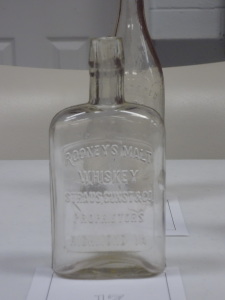
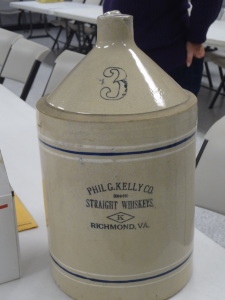
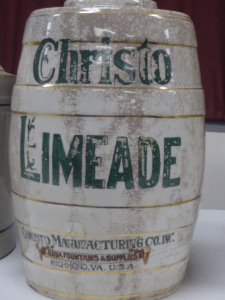
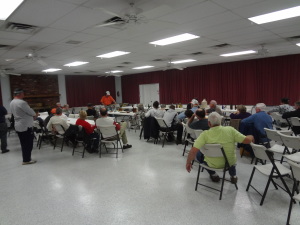
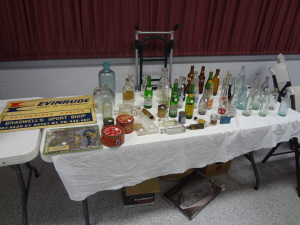
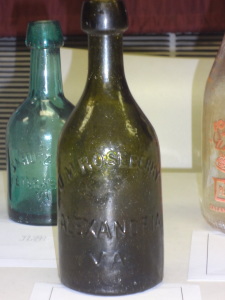
Do you have a Valentine Meat Juice bottle?
Unfortunately we do not. If you’re interested in purchasing one, the folks in this article might have some for sale. The Valentine Museum in downtown Richmond has a bunch. What’s your interest?